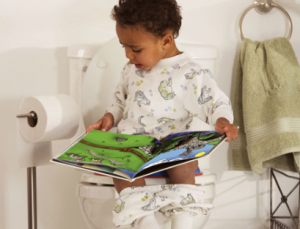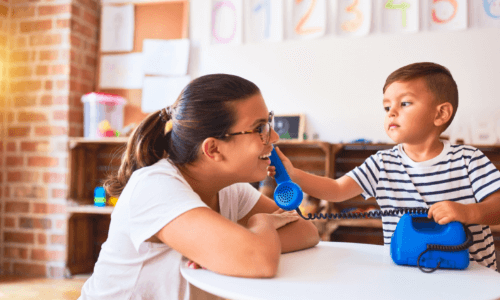Potty Training 101
By Kim Morrow, Developmental Specialist
At teli, through our Early Intervention Services, our therapists help parents work through transitions as their child moves through normal developmental stages. A question that our teli developmental therapists hear on a regular basis is one that parents have been asking for ages:
“When will my child be potty trained? “The answer? Well, it depends. Some children are ready by 18 months while others may not be interested until they are 3 years of age or later. Your child must be developmentally ready to begin the process.
What are the signs that your child is ready to be potty trained?
 Is your child ready for potty training? There are some signs, suggestions and some keys to success that our teli staff shares and ways to encourage your child along the way. The following signals are some of the ways in which you know your child is ready to begin the process:
Is your child ready for potty training? There are some signs, suggestions and some keys to success that our teli staff shares and ways to encourage your child along the way. The following signals are some of the ways in which you know your child is ready to begin the process:
- Pulling at a wet or dirty diaper or communicating they are wet.
- Hiding in a corner when they are about to pee or poop.
- Following others to the bathroom and showing an interest in others’ use of the potty.
- Staying dry for more than 2 hours and awakening dry from a nap.
- Showing interest in pants vs diapers.
- Able to communicate through words, signs or gestures that they need to go, are going or have just gone in their diaper.
- Able to understand and follow basic directions.
- Are able get to the potty, sit on the potty and pull up/down diapers or pants with partial parent assist.
How do you begin to potty train your child?
When you begin to see some of the signs indicating interest, you can begin to build upon those behaviors. It is important to select a time when you can devote yourself to working with your child and not one where you family is experiencing significant change such as a new baby, beginning day care, or an upcoming vacation. Consistency is a key to success. Getting your child comfortable with a new activity will take some time. Parents that teli therapists have advised have found the following suggestions to be helpful.
- Understand your child’s body rhythm by plotting when they have a wet diaper so you can begin to anticipate when it might be time to try.
- Suggest a trip to the bathroom within 20 minutes of eating or drinking to just sit on the toilet for just a few minutes at a time.
- Provide them with opportunities to observe you and talk them through the process of what to do as part of growing up to be a big boy or girl.
- When accidents happen, and they will, remain positive – “Accidents happen, next time we will get to the potty on time!”
- Focus first on their awake time vs. night-time. Begin taking them every 30 minutes into the bathroom to have them attempt. Make it fun by marching into the bathroom!
- Once your child has been successful during the day and want to try at night, restrict fluids and foods to at least an hour before bedtime.
- A note about boys vs girls, while girls tend to show more interest earlier, there is no statistical evidence that one learns quicker than the other.
- If your child becomes resistant or isn’t getting the hang of it after a few weeks of trying, chances are they are not yet ready, and you need to take a break. It is important to not force them.
What are some potty training tricks for success?
While every child is different, the following tips help your child associate a positive reaction with potty training, which can increase their success rate!
- Praise their attempts on the potty with words of encouragement or stickers on a reward chart building to an incentive to do something special such as an activity together.
- Role play potty training with a favorite stuffed animal and let them help the stuffed animal pull down their pants and “sit” on the toilet.
- During the few minutes they are sitting on the toilet, keep their interest when necessary with a story such as Diapers Are Not Forever, Once Upon a Potty or Potty Superhero or songs.
- When possible empty a dirty diaper into the toilet to show what you want your child to do.
- With boys, consider beginning by sitting on the potty instead of standing up and when they are more comfortable, consider games such as Cheerios in the toilet as a “tinkle target”.
- Consider adding food coloring in the toilet so that when they are successful, the color changes.
- To reinforce important hygiene habits, use a special animal hand soap container or special sparkly liquid soap to reinforce their success.
It is important to remember potty training for a child with special needs may require some adaptations to the potty and how they are able to access the potty and sink. They also may benefit from ideas to communicate their potty needs and for dressing and undressing.
Our physical, occupational, speech and developmental therapists are able to provide a wealth of information on this subject especially specific to their area of expertise. “Toileting Without Tears” by Dr. Charles E Schaefer is a wonderful book specifically written for potty training children with special needs that could be a helpful parent reference and guide.
Potty training can be a process of three steps forward and two steps back which requires a great deal of patience on both sides. Maintaining a positive attitude is an essential element to your child’s success.
If you have further questions on potty training or other developmental milestones and Early Intervention services for your child, please call teli at 412-922-8322, we can help!


